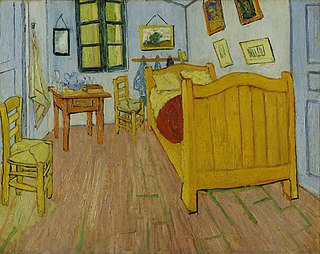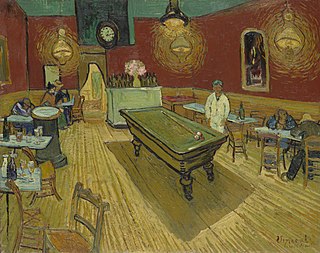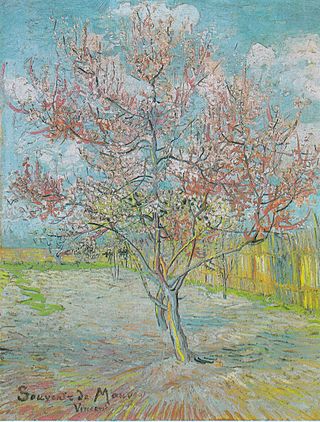
The Starry Night is an oil-on-canvas painting by the Dutch Post-Impressionist painter Vincent van Gogh. Painted in June 1889, it depicts the view from the east-facing window of his asylum room at Saint-Rémy-de-Provence, just before sunrise, with the addition of an imaginary village. It has been in the permanent collection of the Museum of Modern Art in New York City since 1941, acquired through the Lillie P. Bliss Bequest. Widely regarded as Van Gogh's magnum opus, The Starry Night is one of the most recognizable paintings in Western art.

Café Terrace at Night is an 1888 oil painting by the Dutch artist Vincent van Gogh. It is also known as The Cafe Terrace on the Place du Forum, and, when first exhibited in 1891, was entitled Coffeehouse, in the evening.

Les Alyscamps is a pair of paintings ("pendants") by Dutch painter Vincent van Gogh. Painted in 1888 in Arles, France, it depicts autumnal scenes in the Alyscamps, an ancient Roman necropolis in Arles which is lined with poplars and stone sarcophagi.

Fall of Leaves , or Falling Autumn Leaves is a pair of paintings by the Dutch painter Vincent van Gogh. They were executed during the two months at the end of 1888 that his artist friend Paul Gauguin spent with him at The Yellow House in Arles, France.

Starry Night, commonly known as Starry Night Over the Rhône, is one of Vincent van Gogh's paintings of Arles at night. It was painted on the bank of the Rhône that was only a one or two-minute walk from the Yellow House on the Place Lamartine, which Van Gogh was renting at the time. The night sky and the effects of light at night provided the subject for some of van Gogh's more famous paintings, including Café Terrace at Night and the June, 1889, canvas from Saint-Remy, The Starry Night.

Bedroom in Arles is the title given to each of three similar paintings by 19th-century Dutch Post-Impressionist painter Vincent van Gogh.

The Yellow House, alternatively named The Street, is an 1888 oil painting by the 19th-century Dutch Post-Impressionist painter Vincent van Gogh.
Vincent van Gogh lived during the Impressionist era. With the development of photography, painters and artists turned to conveying the feeling and ideas behind people, places, and things rather than trying to imitate their physical forms. Impressionist artists did this by emphasizing certain hues, using vigorous brushstrokes, and paying attention to highlighting. Vincent van Gogh implemented this ideology to pursue his goal of depicting his own feelings toward and involvement with his subjects. Van Gogh's portraiture focuses on color and brushstrokes to demonstrate their inner qualities and Van Gogh's own relationship with them.

The Night Café is an oil painting created by Dutch artist Vincent van Gogh in September 1888 in Arles. Its title is inscribed lower right beneath the signature. The painting is owned by Yale University and is currently held at the Yale University Art Gallery in New Haven, Connecticut.

Flowering Orchards is a series of paintings which Dutch artist Vincent van Gogh executed in Arles, in southern France in the spring of 1888. Van Gogh arrived in Arles in February 1888 in a snowstorm; within two weeks the weather changed and the fruit trees were in blossom. Appreciating the symbolism of rebirth, Van Gogh worked with optimism and zeal on about fourteen paintings of flowering trees in the early spring. He also made paintings of flowering trees in Saint-Rémy the following year, in 1889.

The Langlois Bridge at Arles is the subject of four oil paintings, one watercolor and four drawings by Vincent van Gogh. The works, made in 1888 when Van Gogh lived in Arles, in southern France, represent a melding of formal and creative aspects. Van Gogh used a perspective frame that he built and used in The Hague to create precise lines and angles when portraying perspective.

A Wheatfield with Cypresses is any of three similar 1889 oil paintings by Vincent van Gogh, as part of his wheat field series. All were exhibited at the Saint-Paul-de-Mausole mental asylum at Saint-Rémy near Arles, France, where Van Gogh was voluntarily a patient from May 1889 to May 1890. The works were inspired by the view from the window at the asylum towards the Alpilles mountains.

Landscape with Snow is a painting by Vincent van Gogh in 1888, believed to be one of the first paintings that he made in Arles. It is one of at least ten 1882 to 1889 oil and watercolor van Gogh paintings of a snowy landscape. The painting reflects the La Crau plains set against Montmajour and hills along the horizon.

Wheat Fields is a series of dozens of paintings by Dutch Post-Impressionist artist Vincent van Gogh, borne out of his religious studies and sermons, connection to nature, appreciation of manual laborers and desire to provide a means of offering comfort to others. The wheat field works demonstrate his progression as an artist from the drab Wheat Sheaves made in 1885 in the Netherlands to the colorful and dramatic 1888–1890 paintings from Arles, Saint-Rémy and Auvers-sur-Oise in rural France.

Vincent van Gogh enjoyed making Paintings of Children. He once said that it's the only thing that "excites me to the depths of my soul, and which makes me feel the infinite more than anything else." Painting children, in particular represented rebirth and the infinite. Over his career Van Gogh did not make many paintings of children, but those he completed were special to him. During the ten years of Van Gogh's career as a painter, from 1881 to 1890, his work changed and grew richer, particularly in how he used color and techniques symbolically or evocatively.

Butterflies is a series paintings made by Vincent van Gogh in 1889 and 1890. Van Gogh made at least four paintings of butterflies and one of a moth. The metamorphosis of the caterpillar into a butterfly was symbolic to Van Gogh of men and women's capability for transformation.

Almond Blossoms is a group of several paintings made in 1888 and 1890 by Vincent van Gogh in Arles and Saint-Rémy, southern France of blossoming almond trees. Flowering trees were special to van Gogh. They represented awakening and hope. He enjoyed them aesthetically and found joy in painting flowering trees. The works reflect the influence of Impressionism, Divisionism, and Japanese woodcuts. Almond Blossom was made to celebrate the birth of his nephew and namesake, son of his brother Theo and sister-in-law Jo.

Hospital at Arles is the subject of two paintings that Vincent van Gogh made of the hospital in which he stayed in December 1888 and again in January 1889. The hospital is located in Arles in southern France. One of the paintings is of the central garden between four buildings titled Garden of the Hospital in Arles ; the other painting is of a ward within the hospital titled Ward of the Hospital in Arles. Van Gogh also painted Portrait of Dr. Félix Rey, a portrait of his physician while in the hospital.

Memory of the Garden at Etten (Ladies of Arles) is an oil painting by Vincent van Gogh. It was executed in Arles around November 1888 and is in the collection of the Hermitage Museum. It was intended as decoration for his bedroom at the Yellow House.

Wheatfield Under Thunderclouds is an 1890 oil painting by Vincent van Gogh. The painting measures 50.4 cm × 101.3 cm. It depicts a relatively flat and featureless landscape with fields of green wheat, under a foreboding dark blue sky with a few heavy white clouds. The horizon divides the work almost into two, with shades of green and yellow below and shades of blue and white above. Since 1973 it has been on permanent loan to the Van Gogh Museum in Amsterdam.



















